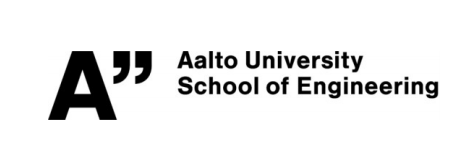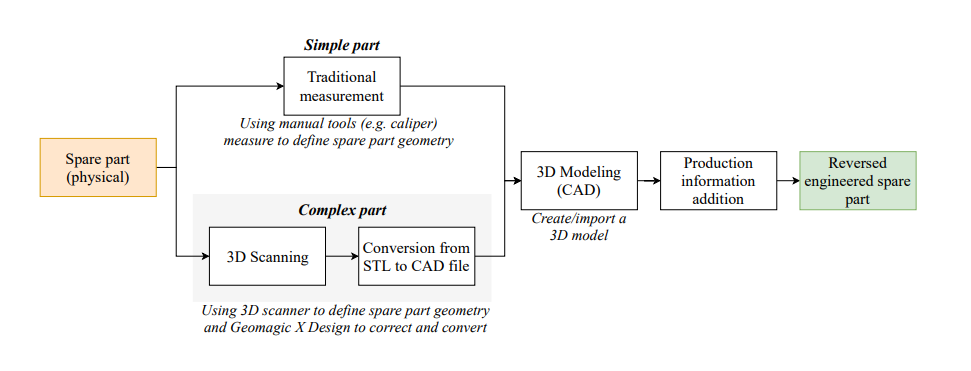 In the recently published, ‘Methods to reverse engineer spare parts,’ thesis student Edoardo Colombo, from the Aalto School of Engineering, expounds on the benefits of digital spare parts, and their potential for creating an entirely new supply chain; after all, if a user has a ‘ready to be produced’ 3D model in hand, with manufacturing instructions, they can easily fabricate a part—and this could extend even to those previously rendered obsolete.
In the recently published, ‘Methods to reverse engineer spare parts,’ thesis student Edoardo Colombo, from the Aalto School of Engineering, expounds on the benefits of digital spare parts, and their potential for creating an entirely new supply chain; after all, if a user has a ‘ready to be produced’ 3D model in hand, with manufacturing instructions, they can easily fabricate a part—and this could extend even to those previously rendered obsolete.
Here, Colombo’s thesis work focuses on reverse engineering methodologies that could produce a spare part simply from the following:
- 2D paper drawing – through 3D modeling of the spare part in CAD software, or with vector graphic aided 3D modeling (via scanning the 2D paper drawing, converting it into a 2D digital drawing in DWG/DXF format and then importing it into a CAD software).
- 2D digital drawing – with PDF to DWG/DXF conversion or importing and modeling.
- Spare part or spare mold/tool to create it – via traditional measurement and 3D modeling or 3D scanning and model refinement.
- 3D model – more information is usually required, with resulting modifications.
Colombo describes five different cases that can be considered during digital spare part (DSP) distribution:
- Data available as 2D paper drawings
- Data available as 2D digital drawings
- Only physical part available
- Only 3D model available
Colombo used SolidWorks, PTC Creo 3.0, and Siemens NX 11 for CAD modeling software, along with a 3D scanner and two specific reverse engineering software programs. During the experimental phase, varying models of a recoil starter were used for testing the reverse engineering concept. The author’s goal was to outline the processes for each input and then analyze which ‘method paths’ work best, along with a discussion of the tools being used.
AM technology could be extremely beneficial in the future for distribution of spare parts, and obviously many aside from Colombo have already recognized this, with so many different parts of the production process either eliminated or minimized in terms of time and expense. Delivery time is transformed as in many cases it can be completed electronically. This means that warehouse space is unnecessary in many cases too.
Scanners are obviously a critical tool and must be chosen specifically for the type of spare part being reverse engineered. Colombo points out also that it may be necessary to combine more than one technology for ‘optimal results.’
“The main disadvantages of this system are the high AM machine acquisition price, personnel intensiveness and the slow production rate; that could be partially covered by a sharp decline in transportation costs, and the already cited decreased inventory, obsolescence and downtime costs,” states Colombo. “The current non-employment of DSP is imputable to a non-readiness of AM processes, that needs further developments in terms of available materials, accuracy levels, tolerances, and building chamber volumes; nonetheless the digital storage of spare parts is considered a great opportunity to reduce companies’ costs.”
In the five tests performed by Colombo, he states that they were all effective, with successful results, except for the conversion from 2D paper drawing to 2D digital drawing. Some ‘critical points’ did arise, however, showing that it takes a very long time to directly 3D model a drawing or to even scan an object. There are simple solutions for this, mainly in buying better tools.
“The limit right now is the computational power needed to perform these automated tasks, but since the trend of price over computational power is decreasing in time is fair to hypothesize a future improvement in this direction. Furthermore, a validation process has been proposed and tested to assess the capability of the production and reverse engineering methods defined. In conclusion the work done in this thesis has shown how it is possible to retrieve a 3D model ready to be additive manufactured of a spare part from each of the potential available inputs, presenting all the pros and cons and the times analysis of the proposed methods,” concludes Colombo.
3D scanning allows for a host of items to be created, seemingly out of thin air for those spectating. Components can be made for many different industries, from automotive to military applications to electronics. What do you think of this news? Let us know your thoughts! Join the discussion of this and other 3D printing topics at 3DPrintBoard.com.
[Source / Images: ‘Methods to reverse engineer spare parts’]Subscribe to Our Email Newsletter
Stay up-to-date on all the latest news from the 3D printing industry and receive information and offers from third party vendors.
Print Services
Upload your 3D Models and get them printed quickly and efficiently.
You May Also Like
The Market and Industry Potential of Multi-Material 3D and 4D Printing in Additive Electronics
Additive manufacturing leverages computer-based software to create components for products by depositing either dielectric or conductive materials, layer by layer, into different geometric shapes. Since its birth in the 1980s,...
3DPOD 262: Bio-inspired Design for AM with Dhruv Bhate, Arizona State University
Dhruv Bhate is an associate professor at Arizona State University. There, he looks at structures, materials, and design. Previously, he worked at PADT as well as in the semiconductor and...
3DPOD 261: Tooling and Cooling for AM with Jason Murphy, NXC MFG
Jason Murphy´s NXC MFG (Next Chapter Manufacturing) is not a generalist service; instead, the company specializes in making tooling. Using LPBF and binder jet, the company produces some of the...
3DPOD 260: John Hart on VulcanForms, MIT, Desktop Metal and More
John Hart is a Professor at MIT; he´s also the director of the Laboratory for Manufacturing and Productivity as well as the director of the Center for Advanced Production Technologies....


































